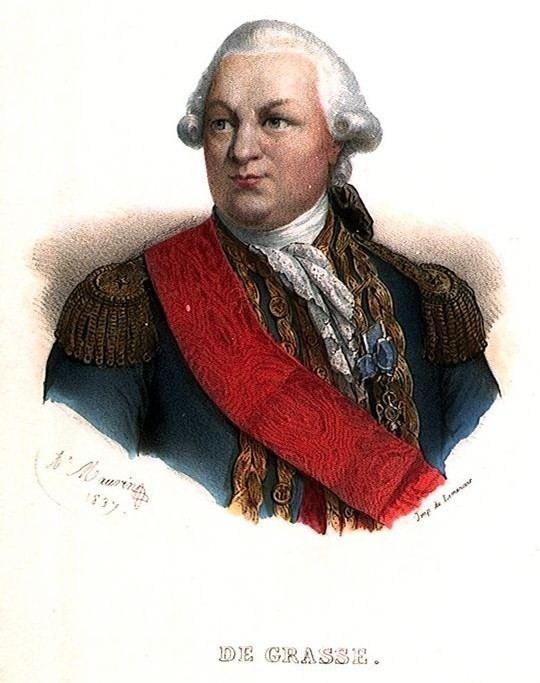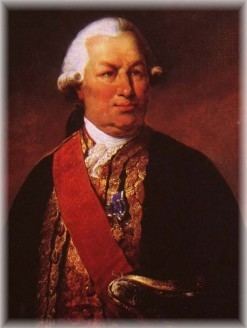Nickname(s) Comte de Grasse Years of service 1734-1784 | Name Francois Paul Rank Vice admiral Role Comte de Grasse | |
 | ||
Battles/wars War of the Austrian SuccessionBattle of Toulon (1744)First Battle of Cape Finisterre (1747)American War of IndependenceBattle of Ouessant (1778)Battle of Grenada (1779)Invasion of Dominica (1780)Battle of St. Lucia (1780)Battle of Martinique (1780)Battle of Fort Royal (1781)Battle of the Chesapeake (1781)Battle of Yorktown (1781)Battle of St. Kitts (1782)Battle of the Saintes (1782) Battles and wars First Battle of Cape Finisterre | ||
Place of burial Saint-Roch, Paris, France Similar Benjamin Lincoln, Alexandre Francois Auguste de Grasse, William Cornwallis Died 11 January 1788 (aged 65) Tilly, Île-de-France, France Nationality French | ||
5th September 1781: Battle of the Chesapeake sees the British repelled during the Revolutionary War
Lieutenant Général des Armées Navales François-Joseph Paul, marquis de Grasse Tilly, comte de Grasse (13 September 1723 – 11 January 1788) was a French admiral. He is best known for his command of the French fleet at the Battle of the Chesapeake, which led directly to the British surrender at Yorktown.
Contents
- 5th September 1781 Battle of the Chesapeake sees the British repelled during the Revolutionary War
- Early life
- Naval career
- American War of Independence
- Yorktown campaign
- Battle of the Saintes
- Later life
- Memorials
- Other vessel names
- References

Admiral Rodney defeated, and captured de Grasse the next year (1872)), at the Battle of the Saintes. de Grasse was widely criticised for this. On his return to France, he demanded a court martial; it acquitted him of fault in his defeat.

Early life

François-Joseph de Grasse was born and raised at Bar-sur-Loup in south-eastern France, the last child of Francois de Grasse Rouville, Marquis de Grasse who earned his title and supported his Provençal family.
Naval career
At the age of eleven (1734), de Grasse entered the Order of Saint John as a page of the Grand Master. He served as an ensign on the galleys in wars against the Turks and the Moors. In 1740 at the age of 17, he entered the French Navy.
Following Britain's victory over the French in the Seven Years War, de Grasse helped rebuild the French navy in the years after the Treaty of Paris (1763).
American War of Independence
In 1775, the American War of Independence broke out when American colonists rebelled against British rule. France supplied the colonists with covert aid, but remained officially neutral until 1778. The Treaty of Alliance (1778) established the Franco-American alliance and France entered the war.
As a commander of a division, de Grasse served under Louis Guillouet, comte d'Orvilliers at the First Battle of Ushant from July 23 to 27, 1778. The battle, fought off Britanny, was indecisive.
In 1779, he joined the fleet of Count d'Estaing in the Caribbean and distinguished himself in the battles of Dominica and Saint Lucia during 1780 and of Tobago during 1781. He contributed to the capture of Grenada and took part in the three actions fought by Guichen against Admiral Rodney in the Battle of Martinique (1780).
Yorktown campaign
De Grasse came to the aid of Washington and Rochambeau's Expédition Particulière, setting sail with 3,000 men from Saint-Domingue. De Grasse landed the 3,000 French reinforcements in Virginia, and immediately afterward decisively defeated the British fleet in the Battle of the Chesapeake in September 1781. He drew away the British forces and blockaded the coast until Lord Cornwallis surrendered, ensuring the independence of the United States of America.
Battle of the Saintes
He returned to the Caribbean, where he was less fortunate and was defeated at the Battle of St. Kitts by Admiral Hood. Shortly afterward, in April 1782, he was defeated and taken prisoner by Admiral Rodney at the Battle of the Saintes. He was taken to London, and while there briefly took part in the negotiations that laid the foundations for the Peace of Paris (1783), which brought the war to an end.
He returned to France and published a Mémoire justificatif. In 1784, he was acquitted by a court-martial.
Later life
He died at Tilly (Yvelines) in 1788; his tomb is in the church of Saint-Roch in Paris.
His son Alexandre Francois Auguste de Grasse published a Notice biographique sur l'amiral comte de Grasse d'après les documents inédits in 1840.
Memorials
There is a monument commemorating Admiral de Grasse and the sailors who helped the United States achieve its independence from the British Crown at the Cape Henry Memorial, Joint Expeditionary Base East, Virginia Beach, Virginia. It is maintained by the Colonial National Historical Park of the National Park Service. A statue of Admiral de Grasse is in the Place de la Tour of Le Bar-sur-Loup, the village where he was born and grew up and another statue is located in the riverwalk landing located in Yorktown, Virginia.
Sometime between 1829-1839, Heman Allen a former U.S. Representative and Ambassador to Chile named the Grasse Mount estate in Burlington, Vermont after Admiral de Grasse.
A. Kingsley Macomber, an American resident of France since the end of World War I, commissioned the monument of Admiral de Grasse at the Trocadero Palace in Paris in 1931.
The Grasse River, which flows through St. Lawrence County, New York, and the hamlet of Degrasse in the township of Russell, are named for him.
De Grasse was the name of two medium-sized French Line passenger ships, one built in 1924 in Scotland, and the other formally the 1956-built Bergensfjord of Norwegian America Lines, which was introduced in 1971. The first ship was famous world-wide, servicing the transatlantic route and later served the allies as a troop ship in World War II. Refitted, she was the first French Liner to inaugurate service after the war's end. After being supplanted by newer ships in the company, the liner was sold in 1952 to Canadian Pacific Lines as an emergency replacement for their fire-damaged Empress of Canada for the busy Coronation Year season, was sold again in 1956 to Grimaldi-Siosa Lines and then to another firm who modernized her further and renamed her Venezuela. After grounding near Cannes in 1962, she was scrapped later in the year.
The second De Grasse served the Le Havre-Southampton-West Indies service with little success, as the old colonial trades were being supplanted by the airlines. West Indies cruises, plus assignments to the Baltic, Mediterranean, and North Africa also suffered mixed profits, she was sold off in 1973, lived under a short string of new Israeli and Greek owners, and, after two fires in 1977 and 1980, was scrapped in Greece.
Ayn Rand claimed to have emigrated to America on the first De Grasse.
Other vessel names
The French Navy has had two vessels named in his honour:
The United States Navy has had three vessels named in his honour:
